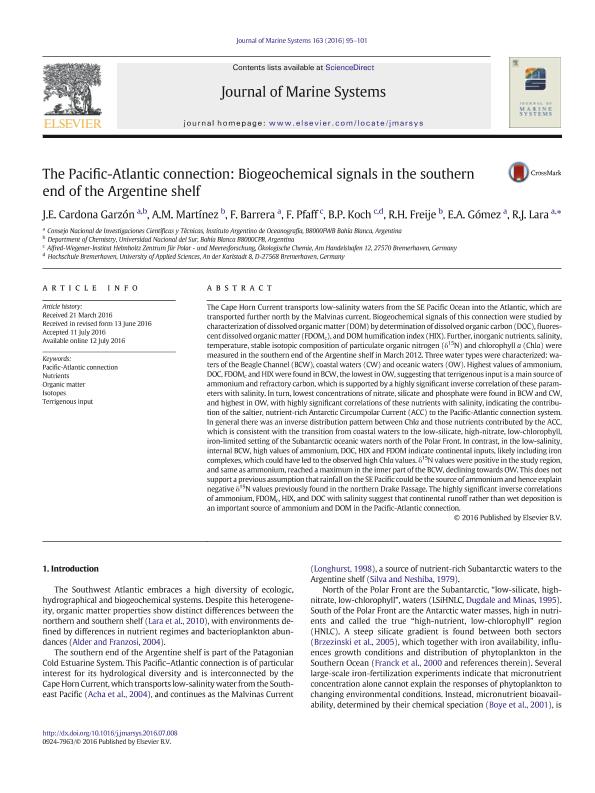Artículo
The Pacific-Atlantic connection: biogeochemical signals in the southern end of the Argentine shelf
Garzon Cardona, John Edison ; Martinez, Ana María; Barrera, Facundo Matías
; Martinez, Ana María; Barrera, Facundo Matías ; Pfaff, F.; Koch, B. P.; Freije, Rubén Hugo; Gomez, Eduardo Alberto
; Pfaff, F.; Koch, B. P.; Freije, Rubén Hugo; Gomez, Eduardo Alberto ; Lara, Ruben Jose
; Lara, Ruben Jose
 ; Martinez, Ana María; Barrera, Facundo Matías
; Martinez, Ana María; Barrera, Facundo Matías ; Pfaff, F.; Koch, B. P.; Freije, Rubén Hugo; Gomez, Eduardo Alberto
; Pfaff, F.; Koch, B. P.; Freije, Rubén Hugo; Gomez, Eduardo Alberto ; Lara, Ruben Jose
; Lara, Ruben Jose
Fecha de publicación:
07/2016
Editorial:
Elsevier Science
Revista:
Journal Of Marine Systems
ISSN:
0924-7963
Idioma:
Inglés
Tipo de recurso:
Artículo publicado
Resumen
The Cape Horn Current transports low-salinity waters from the SE Pacific Ocean into the Atlantic, which are transported further north by the Malvinas current. Biogeochemical signals of this connection were studied by characterization of dissolved organic matter (DOM) by determination of dissolved organic carbon (DOC), fluorescent dissolved organic matter (FDOMc), and DOM humification index (HIX). Further, inorganic nutrients, salinity, temperature, stable isotopic composition of particulate organic nitrogen (δ15N) and chlorophyll a (Chla) were measured in the southern end of the Argentine shelf in March 2012. Three water types were characterized: waters of the Beagle Channel (BCW), coastal waters (CW) and oceanic waters (OW). Highest values of ammonium, DOC, FDOMc and HIX were found in BCW, the lowest in OW, suggesting that terrigenous input is a main source of ammonium and refractory carbon, which is supported by a highly significant inverse correlation of these parameters with salinity. In turn, lowest concentrations of nitrate, silicate and phosphate were found in BCW and CW, and highest in OW, with highly significant correlations of these nutrients with salinity, indicating the contribution of the saltier, nutrient-rich Antarctic Circumpolar Current (ACC) to the Pacific-Atlantic connection system. In general there was an inverse distribution pattern between Chla and those nutrients contributed by the ACC, which is consistent with the transition from coastal waters to the low-silicate, high-nitrate, low-chlorophyll, iron-limited setting of the Subantarctic oceanic waters north of the Polar Front. In contrast, in the low-salinity, internal BCW, high values of ammonium, DOC, HIX and FDOM indicate continental inputs, likely including iron complexes, which could have led to the observed high Chla values. δ15N values were positive in the study region, and same as ammonium, reached a maximum in the inner part of the BCW, declining towards OW. This does not support a previous assumption that rainfall on the SE Pacific could be the source of ammonium and hence explain negative δ15N values previously found in the northern Drake Passage. The highly significant inverse correlations of ammonium, FDOMc, HIX, and DOC with salinity suggest that continental runoff rather than wet deposition is an important source of ammonium and DOM in the Pacific-Atlantic connection.
Archivos asociados
Licencia
Identificadores
Colecciones
Articulos(CCT - BAHIA BLANCA)
Articulos de CTRO.CIENTIFICO TECNOL.CONICET - BAHIA BLANCA
Articulos de CTRO.CIENTIFICO TECNOL.CONICET - BAHIA BLANCA
Articulos(IADO)
Articulos de INST.ARG.DE OCEANOGRAFIA (I)
Articulos de INST.ARG.DE OCEANOGRAFIA (I)
Citación
Garzon Cardona, John Edison; Martinez, Ana María; Barrera, Facundo Matías; Pfaff, F.; Koch, B. P.; et al.; The Pacific-Atlantic connection: biogeochemical signals in the southern end of the Argentine shelf; Elsevier Science; Journal Of Marine Systems; 163; 7-2016; 95-101
Compartir
Altmétricas



